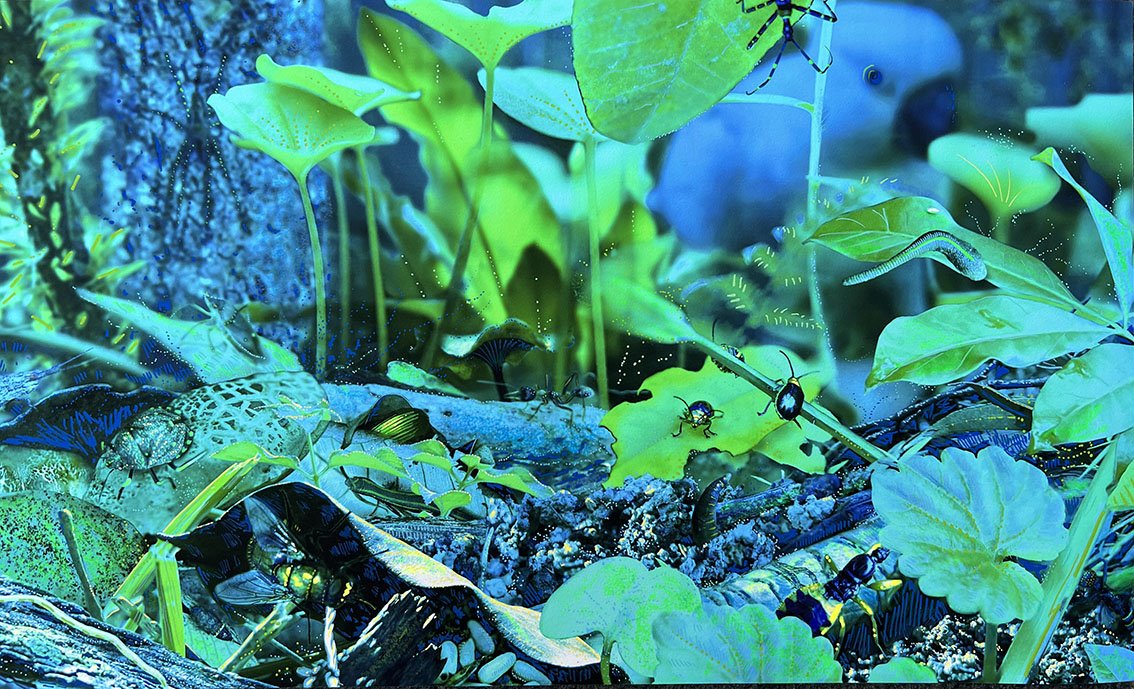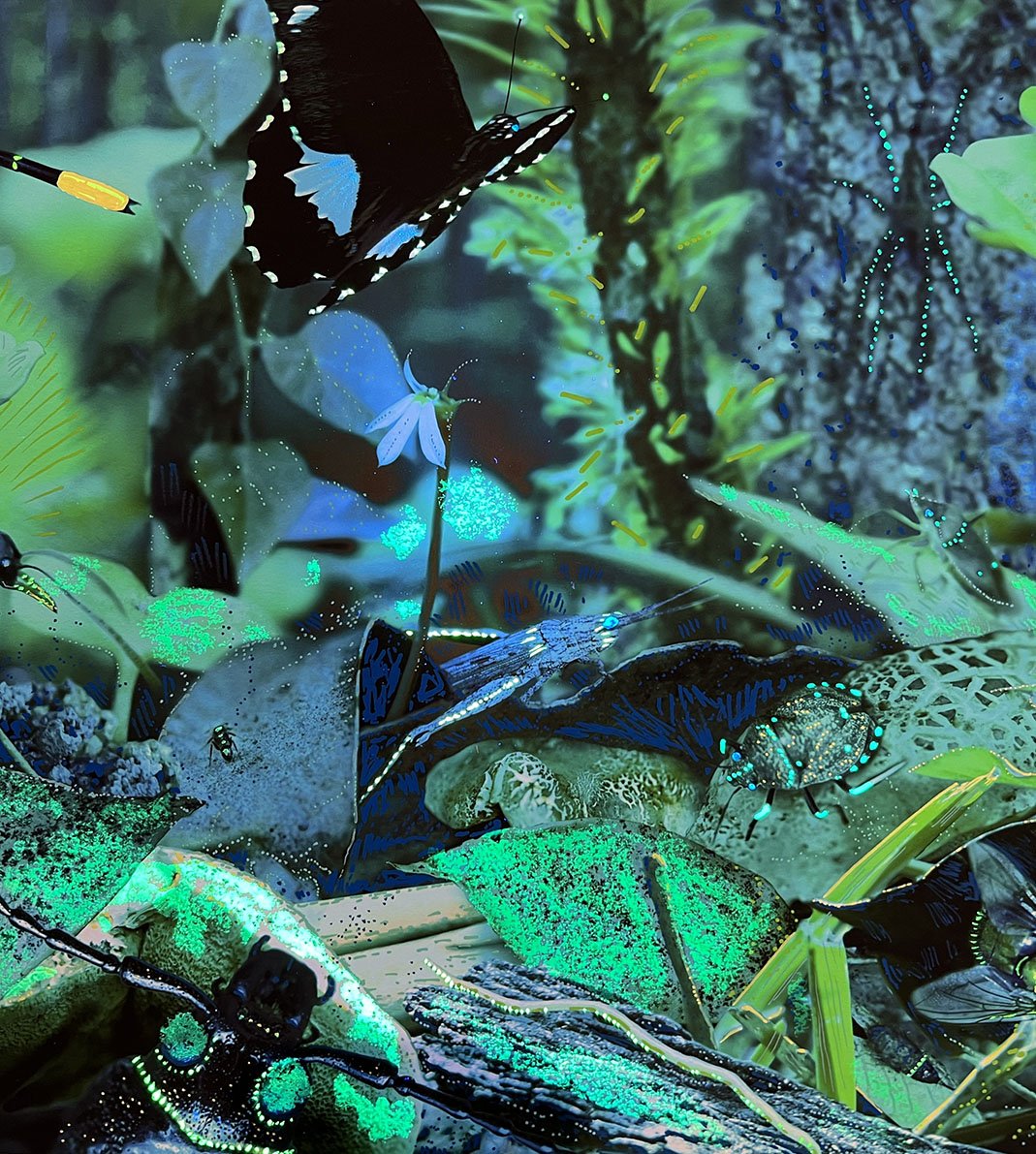Entangled ant vision, Bongil Bongil, northern NSW, 2024
photomontage, acrylic paint, fluoro and invisible ink, UV torch, dimensions variable
This work offers a more-than-human perspective by employing a method of combining photomontage with drawing. It critiques the human tendency to perceive the world in terms of binaries such as human/nature. Could it be argued that the scientific classification of the natural world has reinforced such binaries? The removal of organisms from their entangled setting for study in sterile lab conditions has enriched scientific understanding, but used alone, could this approach miss details of connection and interaction? Perhaps such details may be noticed and understood more deeply through slow non-invasive observation within their natural environment.
The ‘scientific gaze’ has historically used vision to reinforce its claim to objectivity. This is countered by the work’s feminist gaze, acknowledging my situatedness and adopting humility and slowness to perceive the liminal details of an alternate viewpoint – that of an ant. The ant’s ground level perspective reveals details of her world that are normally hidden from a human viewpoint. The hues of green, blue, yellow and ultraviolet reflect the visual spectrum of the Australian bull ant, a large ant that uses her exceptional vision instead of pheromones for navigation and hunting. Using a black light, ultraviolet is illuminated in hand-drawn elements in invisible ink and UV paint (lower image). The crisp foreground blurs as it recedes to reflect the bull ant’s visual distance of around 1.5 metres. It is hoped that this speculative interpretation of more-than-human vision will inspire wonder at the entanglements between living matter at macro level.
The photomontage was slowly constructed into over 90 layers using macro photographs that were taken during in-situ observation in Bongil Bongil National Park, south of Coffs Harbour, NSW. The organisms in the work were identified with assistance from the citizen science platform iNaturalist, and are listed at the bottom of this page.
The mock-up below illustrates the project’s planned final design – to offer an immersive experience of the ant’s scale and perspective. The immersive experience will be augmented by an original audio track based on the ant’s ability to sense vibrations in place of conventional sound.

Entangled ant vision, Bongil Bongil, northern NSW (detail 1)

Entangled ant vision, Bongil Bongil, northern NSW (detail 2)

Entangled ant vision, Bongil Bongil, northern NSW (detail 3)
What is in the collage?
European honey bee, Apis mellifera (foreground)
Red-tipped shadefly, Argiocnemis rubescens (top left)
Australian Orchard Swallowtail butterfly, Papilio aegius aegius
Ant, genus Pseudoneoponera (lower right)
Pony ant, genus Rhytidoponera
Jumping Jack bull ant, Myrmecia nigrocincta
True bug, Ectomocorus ornatus (foreground)
True bug, Poecilometis gravis
Stink bug, Poecilometis cooki
Common Assassin bug, Pristhesancus plagipennis
Longhorned beetle, Coleoptera, subfamily Prioninae
Bess beetle, family Passilidae
Beetle, Platycorus
Leaf beetle, genus Oides (x 3)
Marchfly, family Tabinidae
Cicada (shell)
Grasshopper, Coryphistina
Giant water spider, Megadolomedes trux
Horsehair worm, Phylum Nematomorpha
Leech, subclass Hirudinea
Earthworm, Lumbricus terrestrus
Sulphur-crested cockatoo, Cacatua galerita
Yellow-faced whipsnake, Demansia psammophis
Plants
Grey gum, Eucalyptus propinqua
Scribbly bark gum, Eucalyptus haemastoma
Grevillea
Crofton weed, Ageratina adenophora
Forest lobelia, Lobelia trigonocaulis
Ponysfoots, genus Dichondra
Shrub, Dogbane family
Cabbage tree, genus Cordyline
White root, Lobelia purpurascens (orchid-like)
Elkhorn fern, Platycerium bifurcatum
Fern, genus Pyrrosia
Birds nest fern, Asplenium nidus
Candle vine, Pothos longipes
Tapevine, Stephania japonica
Climbing Guinea flower, Hibbertia scandens
Dogbane vine, family Apocynaceae
Boletes mushrooms, family Boletaceae
Bracket fungi, family Polyporaceae
RHS: details of the collage show the black light torch highlighting invisible and fluoro inks to reveal some of the organisms.



